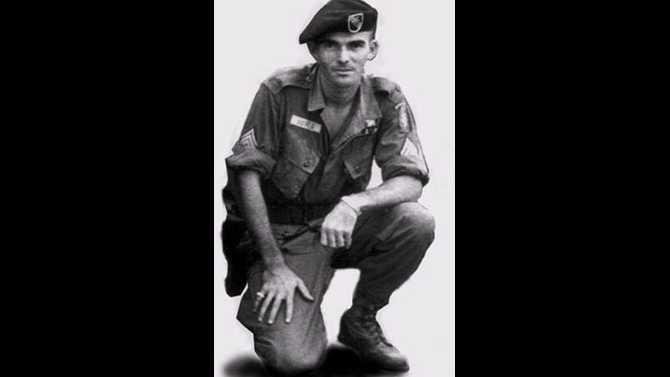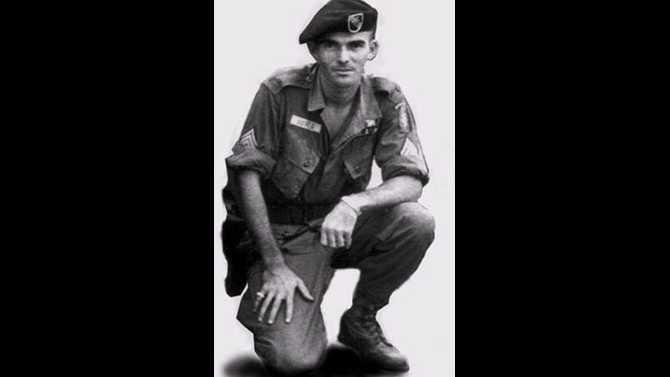The home city of record for Lance Corporal David Nipper is Atlanta. Perhaps the city of Atlanta was listed for convenience, but my theory is a bit more skeptical. This young marine was unintentionally overlooked due to careless record-keeping or the lack of clerical experience dealing with Georgia’s first warrior listed as MIA (Missing in Action) during the war in Southeast Asia.
David was born on Sept. 15, 1940 in Douglas, Coffee County, Georgia, to Jesse and Oleph Nipper. The dinner table must have been a sight to see and most likely an exercise of ‘first come, first served’ since David had to compete for a piece of chicken with 11 brothers and seven sisters. The records I unearthed indicate David was a bright student, the winner of the 1958 Future Teachers of America Essay Contest and a graduate of Nicholls High School. He also attended Berry College in Rome, GA. Yet, a clear photo of David seems unobtainable.
We do know that David answered his call to duty and joined the United States Marines. He was soon 10,000 miles from home participating in the early stages of the Vietnam War. On Nov 21, 1964, David was listed as a ‘passenger’ on a UH-34D Seahorse helicopter flying from the Navy carrier USS Princeton. The chopper was shuttling bags of rice and flour to local Vietnamese who were starving due to harsh flooding from the monsoon season.
Shortly after takeoff a “Mayday” distress call was heard and witnesses saw the chopper go into auto rotation (a loss of power). The pilot tried to maneuver the aircraft into the sea for a gentle roll on its side but the chopper flipped over when the rotor blades hit the water. The accident took the lives of two warriors, but one body was never recovered, that of Lance Corporal David Nipper. The newspaper clipping of the tragic event even misspelled Nicholls, GA as Nichols. David Nipper was the first Georgian missing in action but there would be 50 more before the Vietnam War was over, plus 1 who died in captivity.
June 16, 1973: Captain John J. Smallwood, USAF, of Marietta, was flying as the Weapons System Officer on an F-4 Phantom Jet piloted by Captain Samuel B. Cornelius. The Phantom was hit by anti-aircraft fire over Lomphat, Cambodia; no one ejected from the damaged fighter-bomber. Captain Smallwood and the pilot, Captain Cornelius, became the last two Americans to die in combat in the Vietnam War. They are still listed as MIA. By a cruel twist of fate, Captain Smallwood had been sent on TDY (temporary duty assignment) from Udorn Royal Thai AFB to Ubon Royal Thai AFB to fly with Captain Cornelius due to a shortage of Weapons System Officers.
Two Georgians lost their lives on the same day, Dec 21, 1972, but under very different circumstances.
Bob Kirby of East Point, enlisted in the Aviation Cadet Program for the USAF on Nov 6, 1952. He earned his Navigator Wings and Second Lieutenant Bars in Dec, 1953 and became a seasoned Radar Navigator flying on RB-36 Peacemakers, B-57 Canberras, and the legendary B-52. Kirby earned his third Distinguished Flying Cross over North Vietnam on Dec 21, 1972 while deployed for Operation Linebacker II with the 340th Bomber Squadron. This was his second combat tour. His B-52 was hit over Hanoi yet the crew stayed on target and completed their mission even knowing the loss of their aircraft was imminent. Major Bob Kirby was reported as MIA. Promoted to Colonel while still missing in action, his remains were eventually discovered and returned home on Dec 15, 1988, almost 16 years after his last bombing run.
On the same day in 1972, Captain Stanley N. Kroboth of Savannah, GA departed Ubon Royal Thai AFB in Thailand as the copilot of a Lockheed AC130A gunship named “Thor.” Their mission was to interdict enemy movement on the infamous Ho Chi Minh Trail in Laos. Thor carried a crew of 16. Dropping inexplicably to a lower altitude, Thor was hit by enemy ground fire. The decision was quickly made to return to base. Fuel accumulated ankle deep in the cargo area. Within 10 minutes an explosion severely damaged the aircraft.
Communicating with other aircraft in the area, Thor’s crew reported no injuries due to the explosion. However, most of the crew moved to the rear of the aircraft to prepare for bailout, leaving the pilot and copilot aboard to hopefully nurse the plane home. The ‘jump bell’ was heard over friendly headsets; then Thor exploded. Two men made it out; the rest of the crew went down with Thor. Controversy has plagued Thor ever since. Remains were discovered over the years, identities denied then identified again, families spent money on independent studies to be disappointed by the results. Nevertheless, Captain Stanley Kroboth of Savannah finally came home on July 1, 1985. At least for one family closure had been achieved.
Not so for the family of Special Forces First Sgt. James Emory Jones of Alapaha, GA. Early in war on Oct. 3, 1966 Jones was part of a seven-man recon team inserted by helicopter into Laos near the Ho Chi Minh Trail. The unit came under enemy fire almost immediately. The recon team called for emergency extraction but became quickly surrounded. The rescue choppers were driven off by heavy enemy fire. Trying to better their odds, the team split up to evade and hopefully escape the enemy. In the end, only one team member evaded capture or death, a South Vietnamese assigned to the mission, Bui Kim Tien. Given a debriefing and a polygraph test, Tien went on record as saying most of the recon team was wounded but did not know their fate. First Sergeant James Emory Jones’ fate is still unknown. To further complicate matters, of the nearly 600 Americans who disappeared in Laos many were known to be alive on the ground. The Laotians admitted holding “tens of tens” of American POWs, but these men were not part of the negotiations in the Paris Peace Talks because Laos was not part of the agreement that ended the war.
The only Flight Surgeon missing from the Vietnam War is also from the Peach State, Major Bobby Marvin Jones of Macon. Major Jones caught a non-combat ‘hop’ on an F-4 Phantom Jet from Udorn, Thailand to Da Nang, Vietnam on Nov. 28, 1972. The purpose of the flight was to log flight hours so Jones could maintain his Flight Surgeon Status.
Approximately 18 miles from Da Nang the Phantom disappeared from the radar screen. There had been no voice contact or any indication that something was wrong. Hours later emergency signals were heard from the area but rescue attempts were hampered by heavy monsoon rains and enemy held territory. Rescue teams entered the area 3 days later but there was no sign of Major Jones or the pilot, Jack Harvey. A good possibility exists that both men became POWs, yet no record or word has ever surfaced on either Jones or Harvey. Intelligence sources and over 6,000 reports of sightings since the US pulled out of Vietnam indicate that a few of the almost 200 men known to be missing yet still alive at the time of the pullout may be living and in captivity.
Bobby Jones sister, Mrs. Jo Anne Shirley, has led an untiring effort to find her missing brother as well as other men missing in action. Mrs. Shirley was 25 years old when she lost her brother. She has traveled to Vietnam and visited the crash site but the results were discouraging. I met Mrs. Shirley at the recent Walk of Heroes POW/MIA salute for the 228,000 Georgians who served in Southeast Asia. Her inspiring speech was heartfelt.
Georgia lost 1,584 of her sons in Vietnam, 8,534 were wounded, 32 are still listed as Missing in Action, and the remains of 18 have been found and repatriated. MIAs from the Revolutionary War are unknown, the Civil War approximately 6,750, WWI 3,350, WWII a staggering 78,773, Korea 8,177, the Cold War 126, and Vietnam 2,646. Since Vietnam, in the Gulf War, Afghanistan, Iraq, and ‘hot spots’ worldwide, the United States military has achieved a remarkable record: 0 MIAs.
One thing was clear from my research: most, if not all, of our MIAs from each conflict has become a mere footnote to history by the powers that be. Private alliances of patriotic Americans and family members of the forgotten are still the main driving force to bring our boys home.
The initials MIA denote human beings who left home to answer their call to duty and simply disappeared while doing that duty. Imagine a husband, wife, or child leaving home for work or school then is never heard from again. That’s the coldness of Missing in Action, of fighting government agencies for results and information, of having to deal with foreign governments both friendly and hostile, and of untold numbers of unanswered prayers. For the families of MIAs there is no closure, only hope.
Pete Mecca is a Vietnam veteran, columnist and freelance writer. You can reach him at aveteransstory@gmail.com or aveteransstory.us.





